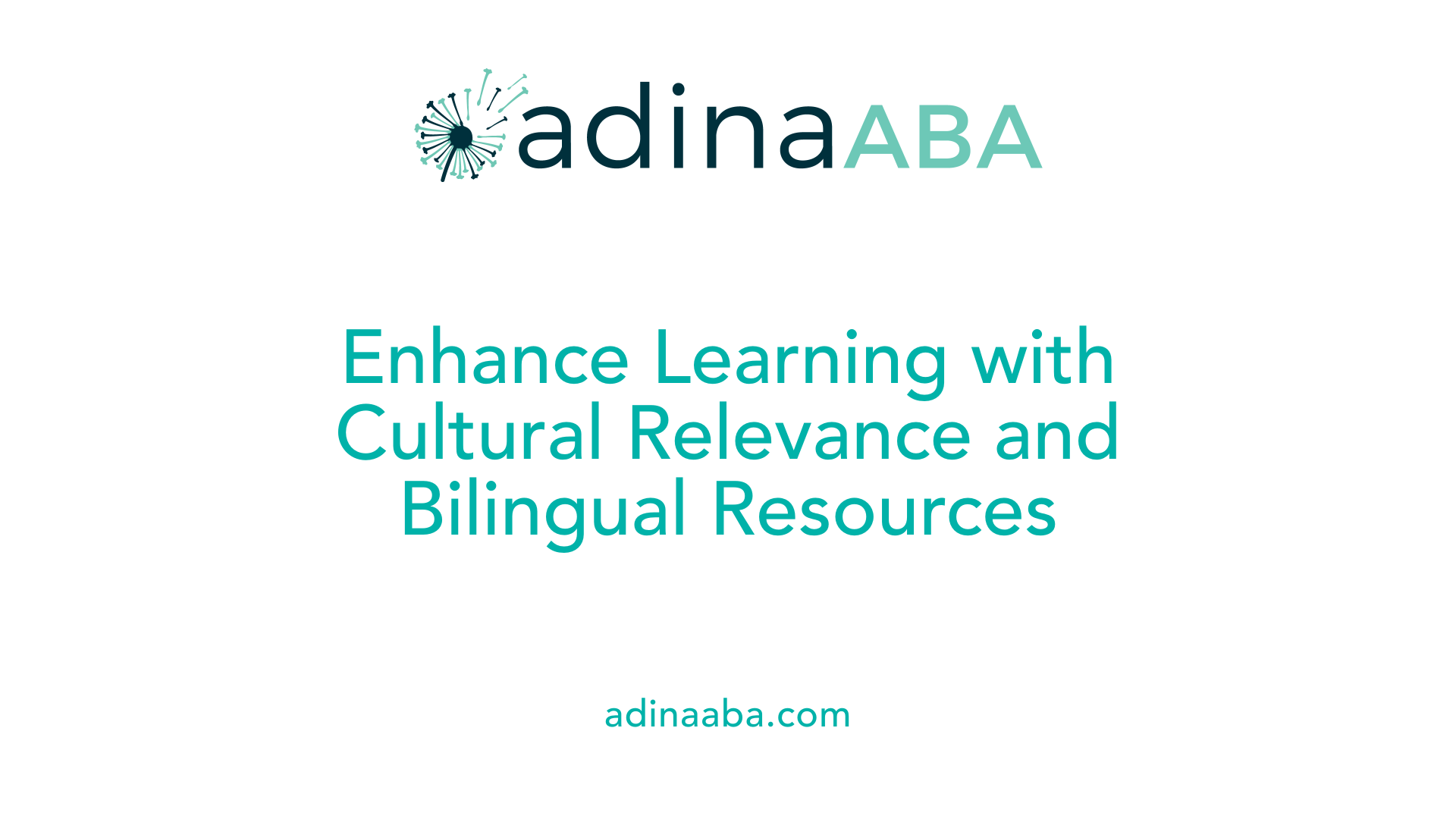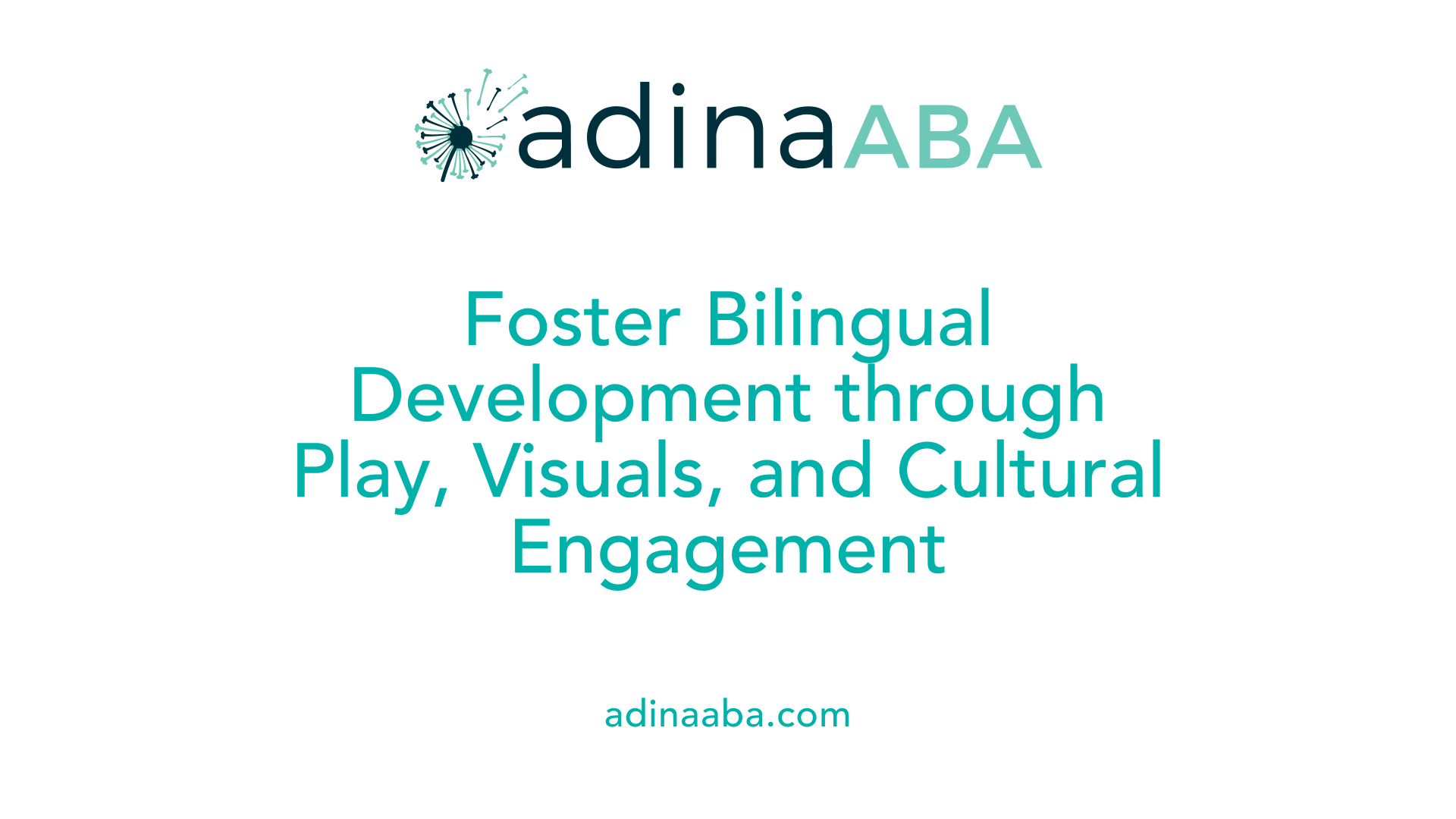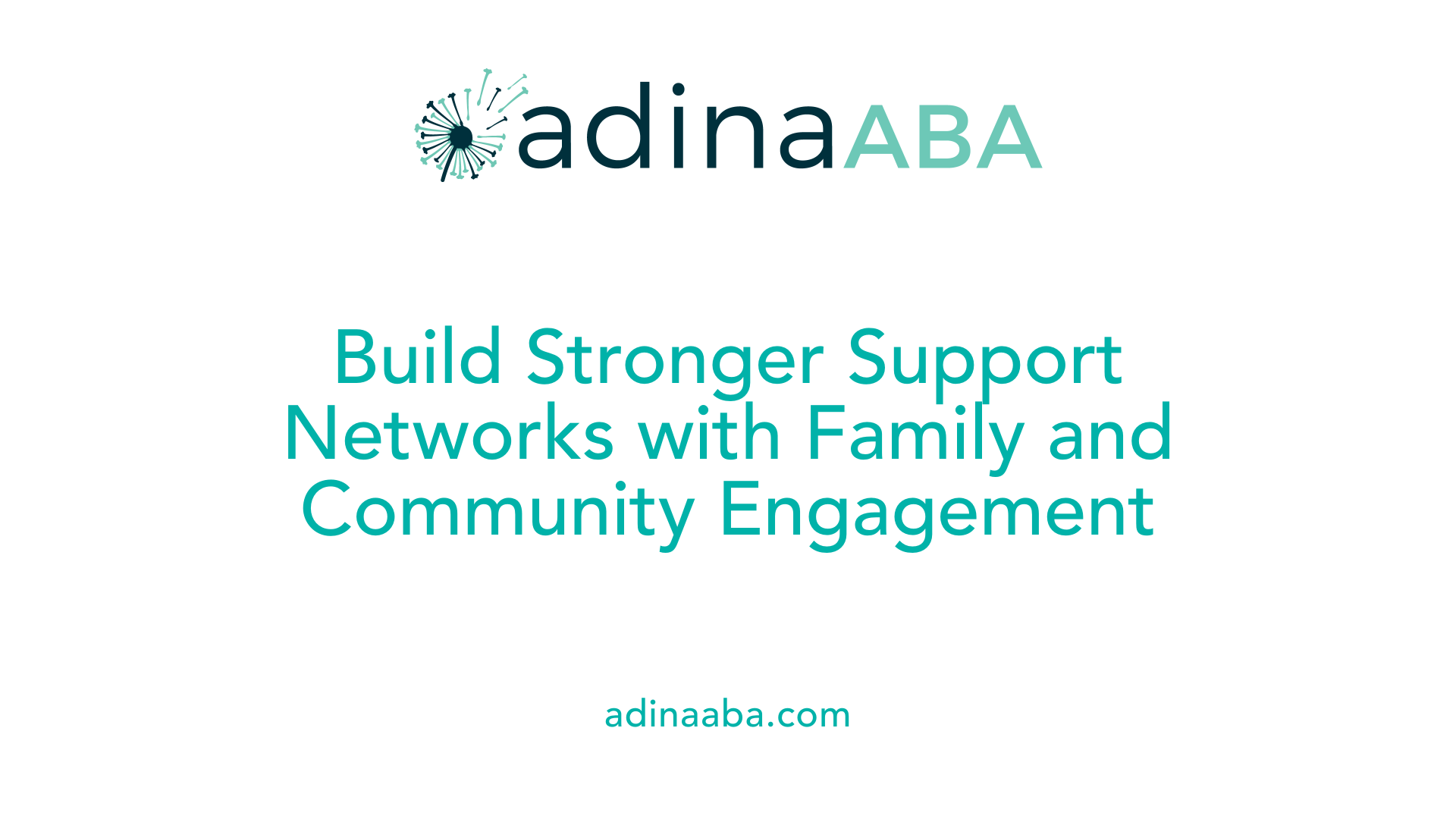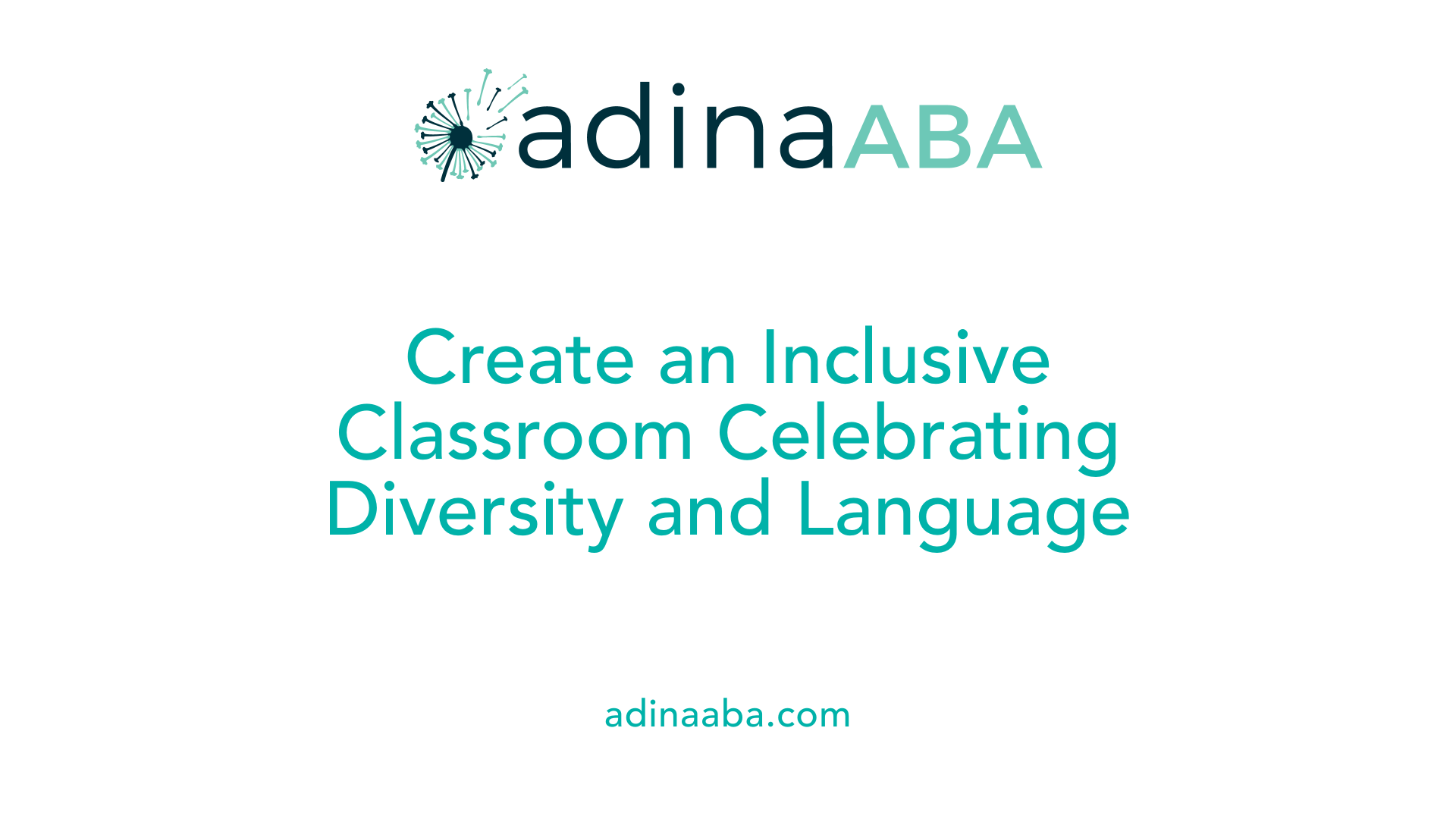Supporting dual-language learners in ABA

Understanding the Significance of Supporting Dual-Language Learners in ABA
Supporting dual-language learners (DLLs) within ABA frameworks presents unique opportunities and challenges for educators, therapists, and families. Embracing bilingualism not only broadens cognitive and social skills but also fosters cultural identity and confidence. This article explores strategies based on current research and best practices for effectively supporting DLLs in early childhood and therapeutic settings to ensure equitable, inclusive, and developmentally appropriate care.
Cultural and Linguistic Integration in ABA Support Strategies

Why is it important to incorporate students' cultural backgrounds through culturally relevant teaching examples?
Integrating students' cultural backgrounds into ABA strategies fosters a more engaging and meaningful learning environment. When teaching examples reflect students' experiences, families, and traditions, children feel valued and understood. This approach enhances motivation, participation, and retention of new skills.
For example, employing familiar stories, songs, or activities from a child's culture can make learning more accessible and relatable. It bridges the gap between home and school, fostering positive attitudes toward learning and communication.
Additionally, understanding cultural norms helps educators interpret behavior more accurately and develop respectful, culturally sensitive interventions. This personalization supports a child's emotional well-being and promotes a sense of identity within the educational setting.
How can utilizing bilingual resources support dual-language learners?
Bilingual resources—such as books, multimedia materials, and visual aids—are vital tools in supporting dual-language learners. These resources enable children to make connections between their home language and the language used in educational activities, promoting bilingual development.
Using bilingual books or multimedia helps children understand new concepts while reinforcing their existing language skills. It also reduces frustration, anxiety, and feelings of isolation, creating a more inclusive classroom atmosphere.
Moreover, bilingual resources can serve as bridges for vocabulary building, literacy, and content comprehension. They empower children to express themselves confidently and support their social-emotional development.
What are the benefits and challenges of supporting dual-language learners in ABA?
Supporting dual-language learners within ABA frameworks offers multiple benefits. Bilingualism enhances cognitive skills like problem-solving, mental flexibility, and perspective-taking, which positively influence language and social skills.
It also nurtures cultural identity, promoting confidence and better social engagement. Strengthening understanding of language structures through exposure to two languages can improve literacy and communication skills.
However, this support comes with challenges. Potential issues include language mixing during therapy sessions, slight delays in speech development, and difficulties in assessment due to language differences or cultural variances. Standardized tools may not always accurately reflect progress in bilingual children.
Addressing these challenges requires tailored strategies, such as establishing consistent language routines, incorporating bilingual activities, and collaborating closely with families to ensure culturally and linguistically appropriate interventions.
With proper support, dual-language learners can benefit immensely, enriching their cognitive and social development within ABA therapy.
How can educators and therapists effectively incorporate cultural and linguistic strategies?
Effective support involves several practical approaches:
- Conducting thorough home language surveys to understand each child's linguistic background.
- Providing materials and activities in children's home languages.
- Using visual cues, gestures, and simplified language with the '4 S's' approach: Say Less, Stress, Go Slow, Show.
- Creating a classroom environment that celebrates cultural diversity through decorations, stories, and family involvement.
- Building strong relationships with families to gain insights into cultural practices and preferred communication methods.
- Incorporating bilingual peer groups to facilitate natural language interactions.
- Reducing large group instructions to allow for more individualized, visually-supported activities.
How do behaviors such as acting out or withdrawal relate to language stress?
Behaviors like acting out, withdrawal, or ignoring directions can often signal language barriers, stress, or frustration. When children struggle to express themselves or understand expectations due to limited language skills, they may become overwhelmed or disengaged. Recognizing these behaviors as communication signals rather than defiance is crucial. Identifying triggers—such as confusing instructions or unfamiliar vocabulary—allows educators to modify strategies, such as simplifying language, increasing visual support, or providing additional reassurance. This understanding helps create a supportive environment where children feel safe to communicate and learn.
What strategies support language development for dual-language learners?
Several methods promote effective language acquisition:
- Using visual aids and cues to support understanding.
- Implementing structured routines and predictable schedules.
- Engaging children in interactive activities like games, role-playing, and music.
- Responding to children's interests to build on their communication efforts.
- Encouraging family involvement to reinforce language skills at home.
- Supporting the home language alongside English, recognizing its role as a resource.
- Offering continuous assessment to monitor progress and adapt interventions.
How does learning multiple languages benefit the brain?
Bilingualism strengthens cognitive flexibility, making it easier to switch between tasks and think creatively. It also improves problem-solving skills and memory. Exposure to two languages enhances understanding of language structure, grammar, and vocabulary, leading to better comprehension and expressive abilities.
Socially, being bilingual opens opportunities for broader community engagement and cultural participation. These benefits contribute to a well-rounded, adaptable, and confident individual.
What professional supports are available for bilingual children in ABA?
Specialized programs in areas like Apple Valley, CA, demonstrate how ABA therapy can be tailored for bilingual learners. These programs incorporate bilingual language goals within their interventions.
Using ABA techniques such as language modeling, reinforcement, and visual aids helps promote language skills specific to each child's linguistic background.
Professional providers work closely with families to ensure interventions respect cultural and linguistic diversity, making the therapy more effective.
Programs like 'The Essentials' guide educators in creating inclusive, developmentally appropriate environments that celebrate bilingualism and foster language development.
How can educators prepare to support dual-language learners?
Preparation involves:
- Conducting home language surveys.
- Equipping classrooms with bilingual materials.
- Teaching children cross-linguistic communication strategies.
- Training staff to understand cultural nuances and language development stages.
- Connecting with families to gather insights and foster collaboration.
In what ways does understanding student behavior aid in intervention?
Observing behaviors like acting out or withdrawal helps identify stressors related to language barriers. Understanding emotional triggers allows for personalized strategies to reduce frustration. This awareness enables the development of more effective, compassionate interventions that support both language and emotional growth.
| Aspect | Approach | Benefits |
|---|---|---|
| Cultural Integration | Use culturally relevant examples and activities | Greater engagement, respect, and identity affirmation |
| Bilingual Resources | Employ books, multimedia, visual aids in both languages | Improved comprehension, reduced anxiety |
| Behavior Observation | Recognize language-related stress signals | Targeted interventions, emotional support |
| Family Collaboration | Engage families in planning and strategies | Consistency, cultural alignment, trust |
This comprehensive approach creates a richer, more inclusive environment that respects and promotes bilingual development, ultimately supporting children’s overall growth and learning in ABA settings.
Multimodal and Play-Based Learning Approaches

What are some best practices for supporting bilingual children in early childhood settings?
Supporting bilingual children effectively involves embracing their cultural and linguistic backgrounds. Educators should incorporate diverse stories, songs, and learning resources in multiple languages to create an inclusive environment. Using visual supports like gestures and picture-word matching helps children understand new vocabulary and concepts.
In addition to using diverse resources, hands-on and play-based activities are vital. Engaging children with games, role-playing, and musical activities encourages active language use and enhances learning. These activities make language learning fun and relatable, which boosts confidence and participation.
Building background knowledge about different cultures through experiences such as cultural displays, celebrations, and family involvement strengthens learners’ identities. Routine integration of dual language supports—like introducing new words during play or group projects—fosters meaningful language development.
Effective collaboration with families is essential. Teachers should maintain open communication, respect language preferences, and involve families in bilingual learning activities. Using research-backed strategies like scaffolded instruction and contextual supports helps ensure each child's needs are met and supports their language and literacy growth.
Ultimately, these practices create an environment where dual language learners feel valued, understood, and motivated to develop their full linguistic potential.
How can visual aids, gestures, and picture-word matching facilitate comprehension?
Visual aids are powerful tools for supporting dual-language learners. Pictures, symbols, and gestures help children connect words to meanings visually, reducing confusion and supporting memory.
Gesture use further enhances understanding by providing non-verbal cues that complement spoken language. For example, pointing to objects or miming actions helps children grasp new vocabulary, especially when language barriers exist.
Picture-word matching activities promote active engagement. Children learn to associate images with words, which improves both receptive and expressive language skills. This method also encourages independent exploration, building vocabulary confidence.
Overall, these visual strategies create a multisensory learning experience, making language more accessible and less intimidating for young learners.
How can interactive activities like games, role-playing, and music promote language skills?
Interactive activities are effective because they involve children actively using language in meaningful contexts. Games such as bingo with vocabulary words or matching games make learning playful and memorable.
Role-playing encourages children to practice real-life conversations and social interactions, helping them develop functional language skills. Acting out scenarios related to daily routines or cultural stories builds both language and social competence.
Music and singing introduce rhythm, rhyme, and pronunciation patterns. Listening to and singing songs in multiple languages enhances phonological awareness and vocabulary. Repetition of lyrics helps reinforce language patterns and makes learning enjoyable.
These activities foster a positive, engaging environment where children feel comfortable experimenting with language, which accelerates their acquisition and confidence.
How can incorporating social stories and natural environment teaching support skill generalization?
Social stories are tailored narratives that teach children about social norms, routines, and language in context. They help children understand expectations and practice communication in familiar situations.
Natural environment teaching (NET) involves using everyday settings—playgrounds, classrooms, home-like areas—as contexts for deliberate teaching. This method encourages children to apply their language skills in real-world situations, promoting generalization.
For dual-language learners, these approaches make language learning relevant and practical. Children see how their language skills translate across settings and interactions, strengthening their ability to transfer what they learn to different environments.
Incorporating social stories and NET helps children develop functional communication and social skills, which are crucial for overall development and bilingual competence.
| Strategy | Description | Effectiveness |
|---|---|---|
| Visual aids, gestures, matching | Use images, gestures, and matching activities to support understanding | Reduces language barriers and builds vocabulary quickly |
| Interactive activities | Games, role-playing, and singing to promote language usage | Encourages active participation and fun learning experiences |
| Social stories, natural teaching | Contextual learning through stories and everyday environments | Enhances skill generalization and real-world application |
This comprehensive approach aligns with best practices in supporting bilingual early learners, fostering an engaging, culturally responsive, and effective learning environment.
Assessment as a Foundation for Tailored Interventions

Why are early and accurate assessments crucial in developing individualized ABA plans for dual-language learners?
Early assessments play a vital role in understanding each child's unique language profile, including their strengths and challenges. Accurate evaluations help educators and therapists design targeted interventions that address both language development and behavioral goals. When assessments are conducted promptly, strategies can be implemented sooner, maximizing learning opportunities and reducing delays. These evaluations also inform decisions about language use in therapy, ensuring supports are aligned with the child's current needs.
How can we utilize culturally sensitive and linguistically appropriate assessment tools?
Using assessment tools that are culturally and linguistically suitable for dual-language learners ensures the accuracy of the results. These tools should be validated for the child's specific language backgrounds and administered by trained bilingual professionals whenever possible. When such resources are limited, alternative approaches like observations, parent and teacher reports, and informal assessments can provide valuable insights. Tailoring assessment methods to respect cultural norms and language differences helps prevent misdiagnosis and supports more effective intervention planning.
Why is family involvement important in the assessment process?
Families offer critical information about a child's language environment, cultural practices, and developmental history. Including families in assessments allows for a comprehensive understanding of the child's abilities across settings and languages. Their insights help clarify whether behaviors are typical for their cultural context or indicative of developmental concerns. Engaging families also promotes trust, encourages consistency between home and therapy environments, and fosters collaborative goal-setting.
| Aspect | Consideration | Additional Notes |
|---|---|---|
| Timing | Conduct assessments early | Enables timely intervention |
| Languages | Use bilingual testers or interpreters | Ensures linguistic accuracy |
| Tools | Employ culturally appropriate tools | Validates results across cultures |
| Family Role | Involve families actively | Offers contextual information |
| Method | Combine formal and informal methods | Provides a comprehensive view |
What are some practical steps for conducting effective assessments of dual-language learners?
Practitioners should begin by conducting a home language survey to understand the child's language exposure and preferences. Selecting assessment tools validated in both languages or conducting assessments in the child's strongest language is essential. It's important to include observations of the child's behavior in natural settings to see how they communicate across contexts. Collaborating with bilingual staff and interpreting services can improve communication and data collection. Additionally, involving families in reviewing assessment results ensures cultural relevance and accuracy, which guides the development of personalized intervention plans.
How do assessments inform intervention strategies for dual-language learners?
Assessment outcomes help identify specific areas where a child excels or needs support, guiding the focus of ABA interventions. Knowing how a child navigates both languages allows therapists to set realistic goals and choose appropriate teaching strategies, such as visual supports or bilingual social stories. Regular assessments help monitor progress and adjust strategies as the child develops. They also facilitate better communication with families about progress and strategies to support learning at home.
By prioritizing early, culturally sensitive, and family-informed assessments, practitioners can craft highly effective, personalized ABA programs that support dual-language learners' linguistic and behavioral growth.
Supporting Families and Community Connections

Engaging family members as active partners in language development and ABA support
Involving families in the educational and therapeutic process is crucial for supporting dual-language learners. Families serve as primary language models and cultural transmitters, making their active participation essential. Educators and therapists can foster collaboration by sharing strategies, progress updates, and resources tailored to the child's bilingual journey. This partnership encourages consistency across home and educational settings, reinforcing language skills and social behaviors.
Empowering families involves providing bilingual materials, such as books and language apps, and offering guidance on how to integrate language learning into daily routines. Engaging families in regular conversations about their child's progress helps build trust and a shared understanding of goals. Additionally, acknowledging cultural practices and respecting family preferences create a welcoming environment that values diversity.
Providing resources and guidance to families to support bilingual development at home
To nurture bilingual growth, families need accessible resources and clear guidance. Distributing bilingual books, educational toys, and links to community resources enables parents to support language development confidently. Offering workshops or training sessions in culturally responsive communication strategies can further empower families.
It’s important for educators and therapists to promote the use of the child’s home language at home, which supports cognitive development and cultural identity. Encouraging parents to share stories, sing songs, or engage in culturally relevant activities strengthens language skills and promotes family bonding.
Building bridges between home and educational/therapeutic environments
Creating strong connections between the child’s home environment and their educational or therapeutic settings fosters consistency and enhances learning. Regular communication allows both educators and families to share insights, adjust strategies, and celebrate successes.
Home visits, bilingual newsletters, and shared goal-setting sessions help ensure that support is culturally and linguistically appropriate. Integrating community events and cultural celebrations within the program can also boost social engagement and cultural pride.
Supporting dual-language learners in ABA: Benefits and challenges
Supporting children in ABA environments offers numerous advantages. Bilingual children often demonstrate enhanced cognitive skills like problem-solving, adaptability, and perspective-taking, which support language and social development. Exposure to two languages helps strengthen understanding of grammar and vocabulary, leading to improved comprehension and expressive abilities.
Social benefits include increased confidence in engaging with diverse social networks and participating in community interactions. Supporting dual-language learners in ABA can also foster cultural awareness, promoting inclusivity and respect.
However, challenges exist. Language mixing, slight delays in speech onset, and difficulties in assessments are common concerns. Environmental factors like standardized testing limitations and cultural differences can complicate progress monitoring. To overcome these hurdles, tailored strategies such as consistent language routines and bilingual activities are essential. Collaboration with families ensures that interventions respect cultural and linguistic backgrounds.
How can you involve families in supporting dual-language learners?
Active family involvement involves regular communication, resource sharing, and cultural validation. Providing bilingual books, language learning apps, and access to community groups creates opportunities for children to practice and enjoy their languages.
Families can support at home by speaking their native language, reading bilingual stories, and participating in cultural activities. Educators and therapists should encourage family members to share traditions and stories, fostering a strong cultural identity.
Training and workshops tailored to bilingual parenting help parents feel confident and engaged. Utilizing bilingual communication methods and culturally responsive materials promotes trust and helps integrate the child's home language into daily routines.
How do community and cultural connections enhance language and social development?
Community engagement provides authentic contexts for language use and cultural expression. Participating in cultural festivals, community events, and peer interactions promotes fluency, comprehension, and social skills.
These experiences foster a sense of pride, belonging, and ownership of both languages. They also affirm the child’s cultural identity, building confidence and motivation.
Educational programs that incorporate relevant community resources and respect cultural backgrounds create safe and inclusive spaces. When children see their cultures valued and represented, their engagement and self-esteem improve, leading to better social integration and lifelong language retention.
| Aspect | Benefits | Challenges | Strategies |
|---|---|---|---|
| Family Involvement | Reinforces language at home, promotes cultural pride, creates consistent routines | Language barriers, limited resources, cultural differences | Bilingual materials, regular communication, cultural events |
| Community & Culture | Enhances social skills, fosters cultural identity, increases motivation | Accessibility of community activities, cultural misunderstandings | Active participation, integration of community resources, cultural celebrations |
| Educational Approach | Improves language skills, supports social engagement, promotes inclusivity | Standardized testing limitations, assessment difficulties | Culturally responsive curriculum, tailor-made interventions, family collaboration |
Supporting dual-language learners requires an integrated approach that values family engagement, cultural identity, and community connections. When these elements work together, children benefit from a rich, supportive environment that nurtures their linguistic and social development across settings.
Building a Culturally Responsive and Inclusive Environment

How can educators create an environment that respects the diversity of languages, cultures, and individual backgrounds?
Developing a classroom or therapy setting rooted in cultural responsiveness involves multiple strategies. First, display multilingual signs and labels to acknowledge and celebrate the varied languages students bring. Incorporate cultural holidays, music, and stories that reflect students’ backgrounds, making them feel seen and valued. Using bilingual books and materials helps bridge language gaps and fosters literacy skills across languages.
Furthermore, training staff on cultural competence and linguistic awareness is crucial. This prepares educators to interact respectfully and effectively with children and families from diverse linguistic backgrounds. Building routines that include multiple languages—such as bilingual storytelling or singing—can also make dual-language learners more comfortable and engaged.
Encouraging family involvement is another vital aspect. Inviting families to share their cultural practices and language perspectives fosters mutual respect and trust. Overall, creating an environment that promotes linguistic and cultural diversity enhances both social and educational outcomes for dual-language learners.
What training should staff undergo to support cultural diversity?
Educator training should focus on cultural competence, linguistic awareness, and inclusive communication strategies. This includes understanding how cultural contexts influence language development and behavior. Training on recognizing and respecting different cultural expressions ensures interactions are supportive rather than unintentionally exclusive.
Staff should learn best practices for using bilingual materials and engaging families from different backgrounds. Ongoing professional development opportunities related to cultural humility and equity help maintain a responsive and adaptive teaching environment.
How can materials and celebrations reflect linguistic diversity?
Using culturally relevant materials—such as bilingual books, music, and art supplies—helps students see their identities represented. Celebrating diverse holidays and cultural traditions in the classroom fosters respect and curiosity.
Display signage in multiple languages, including home languages when possible, to create a welcoming atmosphere. Incorporate storytelling, songs, and games from various cultures to make learning engaging and meaningful.
These practices not only support language learning but also promote inclusivity, making every child feel connected to their cultural identity.
| Strategy | Description | Benefit |
|---|---|---|
| Multilingual Signage | Display labels and signs in multiple languages | Enhances familiarity and comfort |
| Cultural Celebrations | Recognize and celebrate diverse traditions | Promotes respect and inclusion |
| Bilingual Materials | Use books, music, and resources in multiple languages | Supports literacy and cultural identity |
| Family Engagement | Involve families in cultural sharing | Builds trust and community |
Additional practices for fostering inclusivity and supporting dual-language learners
- Build routines that include multiple languages and cultural expressions.
- Provide professional development focused on cultural humility.
- Engage families actively in the educational process.
- Use visual cues and simplified language approaches like the '4 S's' (Say Less, Stress, Go Slow, Show) to improve understanding.
Implementing these strategies creates an environment that respects and values the rich linguistic and cultural diversity of students. It not only supports language development but also nurtures a sense of belonging, positivity, and mutual respect in early childhood settings.
Key Takeaways for Supporting Dual-Language Learners in ABA
Supporting dual-language learners in ABA comprehensively involves recognizing their cultural and linguistic backgrounds, implementing research-based strategies, tailoring assessments, engaging families, and fostering inclusive environments. Employing multimodal, play-based, and culturally responsive methods enhances language acquisition, cognitive skills, and social participation. Collaboration among educators, therapists, and families ensures consistent, meaningful support that respects each child's unique identity. As research continues to affirm the benefits of bilingualism, integrating these practices is essential for promoting equitable, effective, and empowering developmental and educational experiences for dual-language learners in ABA settings.
References
- How To Support Dual Language Learners in the Classroom: 7 Tips
- Dual Language Learners with Challenging Behaviors | HeadStart.gov
- Bilingualism and Autism: Navigating Benefits, Challenges
- The Essentials: Supporting Dual Language Learners in Diverse ...
- Tips for Supporting Dual Language Learners in Early Childhood ...
- [PDF] Systems Framework to Support Dual Language Learning in Early ...
- Understanding the 4 Stages of Learning in ABA
- Autism Program for Kids in Iowa | ChildServe
- What Is the Job Outlook for Behavior Analysts? Career Growth and ...
- Special Considerations: Developmental Screening of Children Ages ...
More Resources
Expert Clinicians
Get started today ->



.jpg)
.jpg)
.jpg)
.jpg)